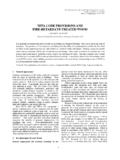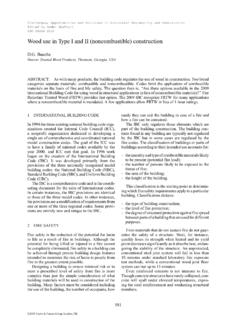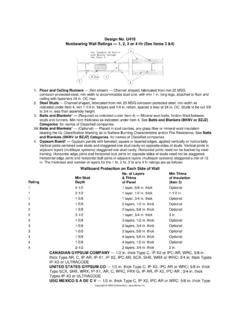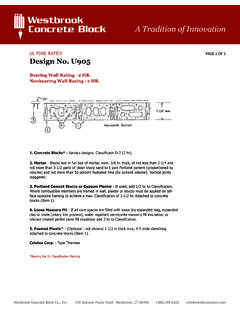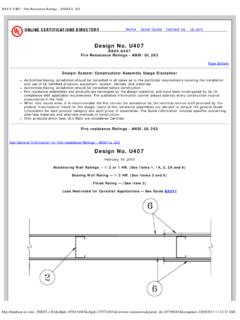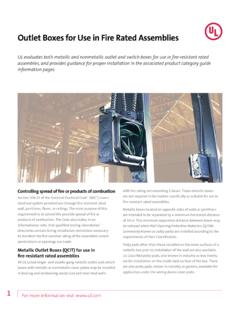Transcription of HOOVER TREATED WOOD PRODUCTS, INC. …
1 HOOVER TREATED WOOD PRODUCTS, NOTEFOR ADDITIONAL INFORMATION: 1-800-TEC-WOOD (832-9663)Fire-Retardant- TREATED Wood Framed Wall AssembliesGENERAL INFORMATIONFire-resistant construction assemblies ( walls , floors, roofs) and elements (beams, columns), that perform satisfactorily in standard fire resistance tests, are documented in building codes, standards, test reports and directories of testing laboratories. Over the years, a considerable amount of accumulated test data allowed the standardization of many fire-resistant designs involving generic (non-proprietary) materials, such as wood, steel,concrete, masonry, clay tile, Type X gypsum wallboard, and various plasters. These generalized designs and methods are documented in the International Building Code, (IBC)1 sections 720 and 721 with detailed explanatory figures, tables, formulas, and charts.
2 Fire resistant designs that incorporate proprietary materials pertaining to specific manufacturers and/or patented are documented by test laboratories in test reports and directories of test laboratories and trade associations. The major sources of documented construction designs rated for fire resistance are described DIRECTORYU nderwriters Laboratories Inc. (UL) conducts tests of various building components and fire protection materials. The assemblies are tested under recognized testing procedures, including ASTM E1192 and ANSI/UL2633, which are essentially the same. When the assembly complies with the acceptance criteria of the fire test standard, a detailed report is provided including its description and performance in the test, pertinent details, andspecifications of materials used. A summary of the important features is produced and given a UL designation.
3 The assembly details are shown in the UL Fire Resistance Directory, Volume 1 and their Online Certifications. Vo l u m e 14 of the UL directory contains hourly fire resistance ratings for beams, floors, roofs, columns, walls and partitions. Assemblies designated with a U3XX are wood framed wall assemblies. These assemblies list untreated wood. However, UL makes the statement in their General Information for Fire Resistance Ratings that, Wood stud walls may contain fire-retardant- TREATED studs as well as untreated wood studs. The use of fire-retardant- TREATED plywood (wood structural panels) may be used in Designs that contain use of untreated plywood when all other specified attributes are equivalent to the wood structural panel used in the Design. Using fire-retardant- TREATED wood in these assemblies allows wood-framed wall systems where noncombustible materials are typically required in Type I, II, III, and IV ASSOCIATIONSTo facilitate the design process, numerous associations publish wall design configurations meeting various fire criteria.
4 Examples of these publications are Fire Rated Wood Floor and Wall Assemblies (DCA-3)5 published by the American Wood Council, Fire Rated Systems Design/Construction Guide (W305)6 published by APA-The Engineered Wood Association, and Fire Resistance Design Manual (GA-600)7 published by the Gypsum Association (see Appendix).BUILDING CODEThe International Building Code (IBC)1 requires that exterior walls conform to the required fire-resistance ratings of Tables 601 and 602. Exterior bearing walls must comply with the more restrictive requirements of both tables, whereas nonbearing exterior walls need only comply with Table 602. The following are the code sections in the International Building Code for Fire-Retardant- TREATED Wood (FRTW) exterior WALL USES FOR FRTWIBC 2006 Type I and II Exterior nonbearing walls with 0 fire resistance or NC materials # bearing and nonbearing walls in joisted masonry (Type III) bearing and nonbearing walls in heavy timber (Type IV) assemblies are required for the exterior bearing walls in Type III and Type IV construction.
5 In Type III and Type IV construction the wood used in the exterior wall must be fire-retardant TREATED . While manyof the provisions are the same for Type III and Type IV, the remainder of this paper will be concerned with Type III exterior walls , the base fire-resistance rating is found in Table 601. The base rating for exterior bearing walls is two hours for both sides. Additionally, the code recognizes the spread of fire from adjacent buildings is reduced by separation. When the fire separation distance is greater than ten feet the rating is from the interior side only (Section ). For nonbearing walls with less than 30 feet fire separation distance the requirement is one hour; over 30 feet, no fire rating is required (Table 602). To qualify under ASTM E119 an assembly must maintain structural stability, limit transmission of heat, and limit transmission of hot gases.
6 Failure to do any one of the three will result in the assembly not passing thetest. All three are important for interior fire rated assemblies. For exterior walls , the building code recognizes the distance between walls can influence fire spread from building to building and has modified the acceptance criteria. The exception in Section states, in part: ..compliance with the ASTM E 119 criteria for unexposed surface temperature rise and ignitionof cotton waste due to passage of flame or gases is required only for a period of time corresponding to the required fire-resistance rating of an exterior nonbearing wall with the same fire separation For a bearing wall in Type III construction with a fire separation distance of 30 feet or more the code is concerned with only structural stability; the limit on transmission of heat and hot gases is not considered.
7 This provides a designer with much latitude in materials for use on exterior side of the wall. EXAMPLES OF TWO HOUR FIRE RATED BEARING WALL ASSEMBLIESWITH FIRE SEPARATION DISTANCE THAT 10 FEETThe modified assemblies shown in this section are based on UL 301 and UL 371. The original assemblies, as tested, have fire protection from both sides. As permitted by the code, the modified assemblies have the fire protection from the inside non-fire side modifiedU371 non-fire side modified Note: See GA File No. WP 8416 for construction details for fire side. Note: See GA File No. WP 8417 for construction details for fire sideFollow manufacturer s recommendations for exterior membranesFollow manufacturer s recommendations for exterior membranesEXAMPLES OF TWO HOUR FIRE RATED BEARING WALL ASSEMBLIES WITH LESS THAN 10 FEET FIRE SEPARATION DISTANCEFor illustration purposes, three UL assemblies are shown: U301, U302, and U371.
8 An additional assembly ( ) which can be found in IBC Table (2) is also shown. Ratings for these two-hour assemblies are from both sides. Figure 1 is a modified version of UL Design U301. This assembly has been modified by adding Pyro-Guard plywood to the exterior side of the wall. Section of the IBC allows modification of an assembly when the modification does not adversely affect the rating. The modification is in accordance with the ten rules for fire endurance developed by Harmathy. The ten rules establish the impactof modifying an assembly and Rule #2 applies in this case, The fire endurance of a construction does not decrease with the addition of further layers. According to Rule #2, Pyro-Guard plywood can be added to anyassembly to provide additional lateral load resistance to the assembly. By adding a weather resistant membrane to UL U301, the gypsum board can also be protected from exterior exposure and again Rule #2 applies.
9 Figure 1 - UL Design U301, ModifiedNote:See GA File No. WP 8416 for construction Pyro-Guard plywood can be placed against the studs or on the outside of the gypsum wallboardFigure 2 is UL Design U302 which utilizes brick veneer for the exterior finish and provides the required fire resistance to both sides of the wall. When resistance to lateral loads is required, Pyro-Guard TREATED plywood can be added to the exterior side without adversely affecting the fire resistance of the 2 - UL Design U302 Note:See GA File No. WP 8410 for construction authority may permit substitution of the Pyro-Guard TREATED plywood for the gypsum sheathing when fire resistanceis needed only from the interior. Figure 3 shows UL Design U371 with an added layer of Pyro-Guard plywood (Rule #2) for resisting lateral loads. U371 is similar to UL Design U302 in that it allows brick veneer or stucco as the exterior membrane.
10 Figure 3 - UL Design U371 Note:See GA File No. WP 8417 for construction TREATED plywood maybe installed over or under the gypsum 4 illustrates a design from Table (2) of the 4 - IBC Design (2) :See GA File No. WP 8420 for construction TREATED plywood maybe installed over or under the gypsum sheathingEXAMPLES OF ONE-HOUR FIRE RATED ASSEMBLIESD epending on the fire separation distance the fire-resistance rating for the nonbearing walls can be either one hour or none. There are many assemblies available in several documents. The Component Added Method (CAM) in Section of the IBC also provides a useful method to calculate the fire resistance of wood framed assemblies. Two assemblies are provided. Figure 5 is for a wall with fire resistance on both sides and Figure 6 is for fire resistance from the interior only. The code requires the wall to be rated from both sides whenthe fire separation distance is ten feet or less.


